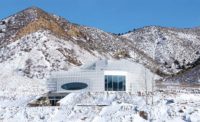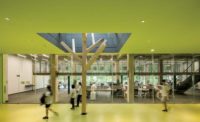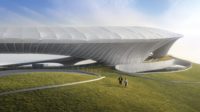The rough peaks and escarpments of the Yin Mountains form a natural barrier between the North China Plain and the Mongolian Steppe. Their vastness and resulting remoteness served for centuries as a bulwark for the Great Wall of China. And while the specter of Khanate incursions has long since faded, those same geographical qualities have fostered a robust tourism and recreation industry today, in the form of ski resorts, and, as of last January, a private airport for two-seat airplane hobbyists.
The Snowland Air Base, designed by Hong Kong–based O Studio Architects, a 2020 RECORD Design Vanguard, is the latest such amenity constructed in the city of Zhangjiakou, in the Hebei province, some 120 miles northeast of Beijing. (The area became a skiing hub following the construction of venues there for the 2022 Beijing Winter Olympics.) The air base rests atop a mountain plateau, and, at approximately 85,000 square feet—the site, including the runway, runs to over 210,000 square feet—houses not only a hangar for private jets and helicopters, but exhibition spaces, a café, administrative offices, and corporate showrooms for the latest aviation products.

In winter, the air base blends into the snowy landscape. Photo courtesy O Studio Architects
Those myriad uses are tucked into several overlapping triangular pavilions, that, facing several different angles, provide numerous vantage points of the surrounding landscape. Their form is low-slung in a move that blends the complex into the horizontal plateau, and the rooflines are canted at points to individuate internal program and amply daylight those public spaces. Within Snowland Air Base, furnishings and detailing are minimal—the surrounding landscape remains the star of the show.
“In different seasons, the building will read completely differently,” says O Studio Architects founder and principal Fai Au. “In winter, it’s almost hidden within the landscape, but, in summer and spring, it emerges as a whole entity. We sought to follow the natural geography and minimize the excavation of soil and the prominence of retaining structures.”

The air base rests on a plateau within the Yin Mountains. Photo courtesy O Studio Architects
Each pavilion is clad with triple-glazed curtain wall modules—they measure approximately 5-feet-wide—that ensure compelling outward views while keeping inclement weather at bay. The 300-foot-long hangar runs horizontal to the runway, and can house eight private jets.
Construction within this tough geography and climate was no easy feat. Work could only commence with the 6-month buildout of an entirely new, 1,600-foot road that winds its way up the steep incline with numerous switchbacks and embankments. In appearance, the road resembles the agricultural terraces that dot nearby hillsides. The harsh winter conditions also informed the construction schedule and choice of materials; concrete, which cannot set at temperatures under 45 degrees Fahrenheit, was off the table. Instead, the design team opted for a steel superstructure, which allowed them to wrap up that phase of the construction schedule ahead of winter, when temperatures drop to 40 degrees below freezing.

The air base is accessed by a steep road with switchbacks and embankments. Photo courtesy O Studio Architects.
The Snowland Cultural Center is another O Studio Architects project in Zhangjiakou that’s currently under construction. At over 200,000 square feet, it will house a suite of leisure and cultural facilities, as well as a substantial reservoir pond to support the surrounding ski resorts. All in all, this corner of the Hebei province is shaping up to be a modern winter wonderland.






Post a comment to this article
Report Abusive Comment